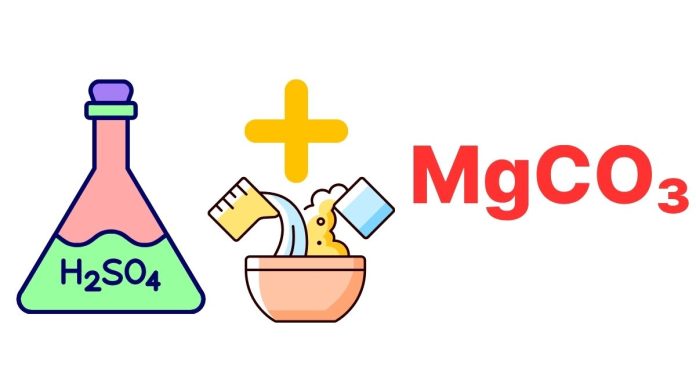The reaction between sulfuric acid (H₂SO₄) and magnesium carbonate (MgCO₃) is a classic example of an acid-carbonate reaction. This reaction is often demonstrated in chemistry labs due to its simplicity and the visible production of carbon dioxide gas. It results in the formation of magnesium sulfate, water, and carbon dioxide.
The Chemical Reaction
When sulfuric acid comes into contact with magnesium carbonate, the two substances react to produce the following:
- Magnesium sulfate (MgSO₄): A soluble salt.
- Carbon dioxide (CO₂): A gas that escapes as bubbles.
- Water (H₂O): A liquid byproduct.
Balanced Chemical Equation:
H₂SO₄ (aq)+MgCO₃ (s)→MgSO₄ (aq)+CO₂ (g)+H₂O (l)
Reaction Mechanism
- Acid-Carbonate Reaction:
- Sulfuric acid, a strong acid, reacts with the carbonate ion (CO32−CO₃^{2-}) present in magnesium carbonate.
- The carbonate decomposes into carbon dioxide gas and water in the presence of the acid.
- Salt Formation:
- Magnesium ions (Mg2+Mg^{2+}) from magnesium carbonate combine with sulfate ions (SO42−SO₄^{2-}) from sulfuric acid to form magnesium sulfate.
Observations During the Reaction
- Effervescence: Bubbles of carbon dioxide gas (CO2CO₂) form, creating a fizzing or bubbling effect.
- Dissolution: The solid magnesium carbonate dissolves as it reacts with the acid.
- No Residue: If the magnesium carbonate completely reacts, no solid residue remains, leaving behind a solution of magnesium sulfate.
Applications of the Reaction
- Laboratory Demonstrations:
- This reaction is often used to teach the principles of acid-carbonate reactions, as it produces visible and measurable results.
- Industrial Applications:
- The production of magnesium sulfate, a compound used in agriculture (as a fertilizer), medicine (as Epsom salts), and water treatment.
- Carbon Dioxide Production:
- In controlled environments, this reaction can serve as a source of carbon dioxide for experiments or industrial processes.
Safety Precautions
When performing this reaction, safety is important:
- Handle Sulfuric Acid Carefully: It is a strong acid that can cause burns. Use gloves and safety goggles.
- Work in a Ventilated Area: Carbon dioxide is non-toxic, but in large quantities, it can displace oxygen in the air.
When sulfuric acid reacts with magnesium carbonate, it results in the formation of magnesium sulfate, water, and carbon dioxide. The reaction is not only a fascinating demonstration of basic chemistry principles but also has practical applications in industry. The visible fizzing and the formation of a clear solution make it a satisfying and informative chemical process to observe.
If you’d like to explore more about similar acid-carbonate reactions or their applications, feel free to ask!


